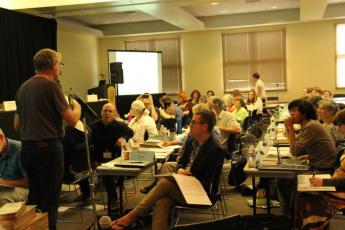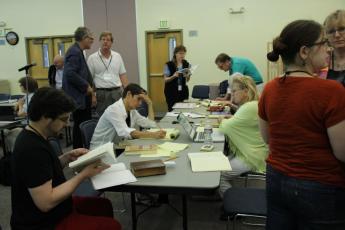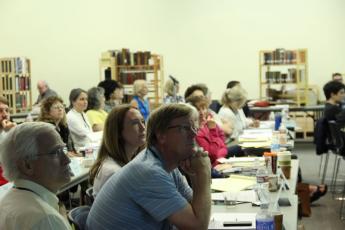Antiquarian Booksellers' Association of America
CABS - The Boot Camp for Book Dealers

By Kenny Parolini
It is a very special week for antiquarian booksellers. From 12th to 17th July young and more experienced colleagues will meet at Colorado College for the Colorado Antiquarian Book Seminar (CABS). More than 2000 students have already graduated from this seminar since its inception, many of whom have gone on to become prominent members of the bookselling community. Under the guidance of the faculty members Lorne Bair, Terry Belanger, Sally Burdon, Brian Cassidy, Dan de Simone, Kathy Lindeman, Nina Musinsky, Robert Rulon-Miller Jr and Steven Escar Smith the seminar provides an opportunity for leading specialists to share their expertise with booksellers, librarians, and collectors in a comprehensive survey of the rare book market, both antiquarian and modern.
“A week at the Colorado Rare Book Seminar is a week like no other I know.”, Sally Burdon wrote in 2014. “It is a highly practical week, it is an inspiring week and it is one of those weeks when, at least metaphorically, you feel you can see for miles.”
Eight years ago Kenny Parolini was among the Colorado students. He shares with us his memories and says: sooner or later every antiquarian bookseller should go to Colorado, it is a once-in-a-lifetime experience one should not miss.
Read his (slightly shortened) report:
“I had been hearing about the Colorado Antiquarian Book Market Seminar, as it is formally termed, for a number of years. Sometime a few years back I started thinking that it might be fun to go. So, with that in mind, I began following up the various emails and notices that showed up in the various chat and news groups on line. I gradually became aware of the occasional adds that appeared in book publications such as Fine Books and Collections and Book Source Magazine.
The Colorado Antiquarian Book Market Seminar was held at Colorado College from Aug. 5th-12th. This year I attended the 2006 seminar and I stayed at Colorado College Inn on campus.
First a little background on my decision to attend. In the early days of the Internet book selling was laughably easy. You bought a lot of books, priced them for something or other and sold them relatively quickly. It turned out that even I could do it pretty well. As time went by it seemed that this was becoming apparent to everyone with a computer. So the pressure began. With the price competition began the race to the bottom.
Before the Internet there was no really reliable way to know how many books were out there of a given title. As book prices became more transparent the high prices being realized brought books out of the barns, attics, trunks and bookshelves of America. What was previously thought to be a good book was now found to be a mediocre book and what was thought to be a mediocre book now became fodder for the soon to arrive penny sellers.
I had always admired penny sellers who bought books by the truckload and sold thousands of them every day. They subsisted mainly on the few pennies in shipping profit they gleaned from each book that they often sold for one penny each. They were doing America a great service in spreading literacy and knowledge and making a profit while doing it. But they were driving many booksellers to the wall. I had no desire to be one of those standing resignedly, back to the wall, with a blindfold across his eyes and a cigarette in his mouth.
I had started very modestly, worked hard and gradually built up a decent inventory. It had become clear to me early on that my only salvation was to buy those books that were sufficiently scarce not to decline in value as more and more books were driven to market. … As sources dry up, and long before retail prices began to rise significantly, cost of acquisition increases. Increased acquisition costs are a direct result of new sellers willing to work for less, a lot less, maybe even nothing. I found it no longer feasible to compete with hobby sellers. The more so because most of them seemed blithely unaware that their business was a hobby.
There was another factor that concerned me as well. I was regularly logging 80 hours or more a week. I knew that it wouldn’t be too many more years before this would begin to lose it’s attraction. I had been there before in other businesses and wanted to avoid that downward spiral at all costs. It was fun and I wanted it to stay fun. So with these concerns turning in my mind I felt that I had to get a different perspective on book dealing. Maybe I had to get many different perspectives. … I felt I had to find new venues, new philosophies, new sources and new customers. In a word I had to reengineer my business or run the risk of perishing as I continued upon what I felt was a parlous path.
There was another concern which made this cross country jaunt to Colorado almost a perfect fit for me. With recently increasing sales I was badly in need of income tax deductions. You might wonder why I was so concerned if sales were on the uptick. The book business needs careful tending. Ignore your income stream at your peril! I needed just a few more tricks in my basket than I already had if I was going to feel at all secure.
So I called and spoke to Kathy Lindeman several times. She was quite forthcoming about the ins and outs of travel, housing and so forth. I owe her a lot and want to thank her again right here. Her assistance in getting me oriented was invaluable. She held my hand while I decided what the best arrangement would be for me.
I hadn’t been in Colorado for more than 25 years. I had passed through once when I was living in Nevada and had found the people so friendly that I seriously considered moving there. I am happy to say I found them just as helpful this time as I did the first. While I was there I checked the real estate ads as I usually do in a new area. There are many very beautiful homes available much more cheaply than is common elsewhere. It is high desert with low humidity. The elevation is about 6000 feet. Annual snowfall is 33 inches. So far, so good, then I found that low temperatures reached 10 degrees F or so. So I’ll stay in New Jersey a little longer. …
The seminar registration was Sunday 3-6 and was quickly disposed of. … I then headed back for the on campus Reception at 7. There was plenty of wine, cheese, foods and conversation, a good time was had by all. Terry Belanger was the keynote speaker. His wit and scholarship are equally well developed. The next morning we began congregating in the cafeteria at about 7. The food was like cafeteria food all around the world but still quite a bit better than I remember it being during my own long distant university days.
We were given full materials for the course including a hefty notebook. The notebook is nicely laid out with sections on everything from where to stay to how to paginate an antiquarian work. This contained invaluable materials compiled from the experiences of the best minds in the business. We also received daily handouts and amplified notes for each class. The whole thing was very carefully thought through and cleanly executed. This is a very valuable resource and one to treasure.
At 8:30 sharp class began. Morning classes ran 3 hours with a 15 minute break. Afternoons about the same. For the most part we ran 6 classes a day. And none of these, and I do mean none, were light weight fill ins. One thing that struck me was how often staff members mentioned that they learned a lot every year from attending. There are so many experts from so many areas. … The average age of the seminarians was a little over 40. The majority had been involved for perhaps a few years and wanted to become more involved. There were also a number of librarians and attendees sponsored by various of the book industries.
In the next 4 days there were two microphones in the aisle between the seats. Those with questions would, (ideally), line up at the microphones and ask their questions. Additionally there was a question box available to drop queries in. These boxes were emptied after each break.
I can’t begin to do justice to the material covered. Each topic would require a paper of it’s own. The best I can do is to skim the subjects to give you the flavor of the sessions and the materials they cover. And perhaps encourage you to find out more for yourself. I have been a long time reader of the works of Kraus, Rosenbach, and other famous dealers. Unfortunately these books are long on stories and short on method. Here are the methods.
After a lifetime of boring and often feckless classes and seminars this whole affair came as the most pleasant of surprises. As I sat in the room gradually the awareness grew on me that I was surrounded by a whole lot of very bright people.
Rob Rulon-Miller was the seminar director. His discussion covered the areas of Catalogue Making, Ethics, and Appraisals. His discussion of catalogues I found particularly useful. There were probably close to 100 different catalogues along a back table in stacks from various dealers. Laid out in such a manner it made choosing the format most suitable for my business much easier. I definitely have a color laser printer on my list of acquisitions for next year. We were free to take what we wanted and there was an open discussion about costs, efficacy, production and problems. Rob also spent a fair amount of time on ethics. Although some might find it restrictive, I thought it simply the best way to run a successful business with as little pain as possible.
Terry Belanger gave an exhaustive and witty talk on Bibliographic Description, Format and Collation. This covered such esoterica as different types of laid paper, watermarks, counter marks and their origins, pagination, and printer’s marks. It was as intensive as it could reasonably be in the short time available. Printed 18th century folio sheets were handed out to the class to help explain various of the printing processes. We were taught how printers numbered sheets so the binders could fold them to form signatures in 8vo, 12mo, 4to and so on. There was a fascinating talk on paper making and how it advanced. Terry said that there was an old saw that the size of the initial sheet of paper was determined by the length of the arms of the papermaker. …
There was a faculty directed workshop on how to write book descriptions and two more on book pricing. We spent some time in class on this and then broke up into groups in various rather nice rooms. There we submitted our books and descriptions for criticism. The groups were, as always, small, and one or two faculty members assigned to each. … Conservation and Preservation by Dan DeSimone and Angela Scott. They combined their skills to give an invaluable look into the nuts and bolts of antiquarian works. Displayed were many materials not commonly seen such as rare leathers and papers. Later on Dan DeSimone presented Libraries as Markets for Books. A look into a world that is a pole apart from internet bookselling. With this information, and it’s diligent application, anyone with at least a modicum of talent could gain entry into this area. He covered the area pretty thoroughly including how to create bibliographical lists and dealing with librarians.
Evaluation and Pricing by Ed Glaser. An internationally known specialist in rare and important books in science, technology and medicine. He noted that keystone for rare books is 1/3, 1/3, 1/3. He explained this as being 1/3 for acquisition, 1/3 for handling and marketing and 1/3 for profit. Ed covered auctions, price guides, dealer’s price lists, the internet and other resources in detail.
Chris Volk discussed Internet Bookselling as well as Buying on the Internet. She went into various websites and their peculiarities as well as ability to move books. We discussed dealing with customers and their questions. One of the promotions she offers is gift wrapping- certainly essential for any Internet seller. … Mike Ginsberg discussed Book Fairs, Scouting, and gave a session on Auctions. Then he conducted an auction of donated materials, some of which were quite worthwhile and brought good prices. The auction included various reference materials, book related items and a dinner with the faculty. Mike has an interestingly disciplined approach to scouting. He lays out the route ahead to time with specific objectives in mind. His comments on equipment for book fairs was very useful. One tip he gave was 'Always bring a flashlight for the top and bottom shelves that no one can see’.
Tom Congalton. Propietor of Between the Covers rare Books. He is also co-owner of Allottabooks.com. Tom made the comment that only 10% of his income came from the Internet. This was a sentiment echoed by many of the faculty. His specialty is modern firsts however he easily fielded questions in any area that came up. He does a number of major shows each year and is well known there. …
During the whole time the faculty were punctilious in making themselves available to answer all questions and give advice where possible. I tried to pick a different table at lunch each day to get a cross section of their philosophies. Everyone was helpful, everyone was gracious and everyone boasted a wealth of experience. Finally, a word about the staff which included 5 past ABAA presidents. These men and women are the legends of tomorrow and the frontrunners of today in the rare book trade. They are well worth listening to.
***
Posted here by permission of Kenny Parolini. Pictures: Maria Lin.




